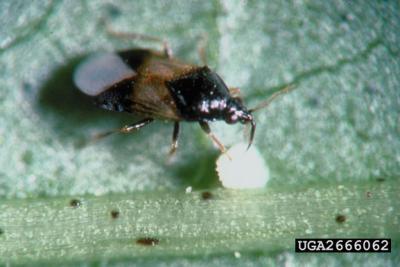A large body of literature has shown that genetically-modified plants that produce proteins from the bacterium Bacillus thuringiensis (Bt) to protect themselves from insect pests have little to no effect on a wide range of nontarget insects. However, concerns about Bt crops still exist. Now two new studies using more exacting methods show that Bt crops have no negative effects on two beneficial insect predators or on a beneficial, entomopathogenic nematode.
In an article in the February 2014 issue of Environmental Entomology, called "Using Resistant Prey Demonstrates that Bt Plants Producing Cry1Ac, Cry2Ab, and Cry1F Have No Negative Effects on Geocoris punctipes and Orius insidiosus," researchers used caterpillars that were known to be resistant to Bt proteins and fed them Bt maize and Bt cotton. They then fed the caterpillars to two common, beneficial, predatory insects -- insidious flower bugs (Orius insidiosus), and big-eyed bugs (Geocoris punctipes) -- for two generations and compared them to another group of predators that consumed caterpillars fed on non-Bt plants.
The researchers found that the survival, development, adult mass, fecundity, and fertility of the insect predators in both groups were similar, regardless of whether they consumed caterpillars that fed on Bt plants or non-Bt plants.
"This research demonstrates that the current Bt proteins used in corn and cotton crops globally do not harm Geocoris punctipes or Orius insidious, two important insect predators that help suppress pest populations on corn, cotton, and many other crops," said Dr. Anthony Shelton, a professor of entomology at Cornell University and one of the co-authors. "By using caterpillars resistant to the Bt proteins in this study, we were able to remove any 'host quality effects' that might have led to spurious misinterpretation of the results. This work demonstrated that the caterpillars consumed the Bt proteins, and the predators consumed the Bt proteins when they fed on the caterpillars, but they did not suffer any harm even over multiple generations."

This shows Geocoris punctipes feeding on an unidentified Homopteran.
(Photo Credit: Russ Ottens, University of Georgia, Bugwood.org)
In a similar article appearing in the February 2014 issue of the Journal of Economic Entomology called "Tri-Trophic Studies Using Cry1Ac-Resistant Plutella xylostella Demonstrate No Adverse Effects of Cry1Ac on the Entomopathogenic Nematode, Heterorhabditis bacteriophora," Shelton and his colleagues used similar methods and found that an important nematode predator was not harmed when it ingested another Bt protein. For this study, resistant caterpillars were fed Bt broccoli and then exposed to Heterorhabditis bacteriophora, a beneficial nematode that preys on insects.
The researchers found that the virulence, reproductive potential, and time of emergence of the nematodes that consumed Bt-fed caterpillars were not significantly affected, compared to nematodes that did not ingest the Bt protein.
"This is the first report we are aware of in which a nematode predator has been tested in such detail against a Bt protein," Dr. Shelton said.
"Together, these two studies add to the scientific literature demonstrating that Bt plants can control targeted insect pests while not harming important natural enemies that help suppress pest species and maintain biodiversity in agricultural systems," Shelton added.

This shows Orius insidiosus feeding on an insect egg.
(Photo Credit: John Ruberson, University of Georgia, Bugwood.org)




Comments